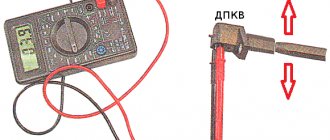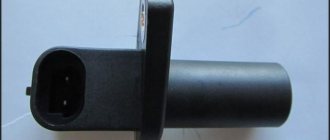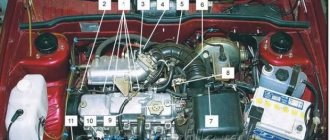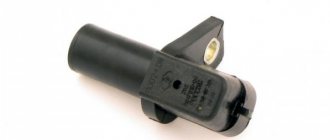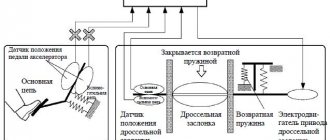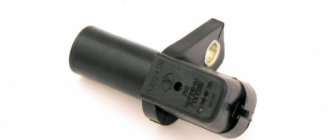The crankshaft position sensor (CPS) is necessary to synchronize the operation of the injection engine control system (ECM) with the position of its crankshaft.
— The car engine does not start
The sensor itself has failed, or its electrical circuit has been damaged. DPKV is the only sensor in the control system of an injection engine; if it fails, the engine will not start.
— The car engine starts with difficulty (starts and stalls)
— Unstable engine idling
— Dips, jerks when pressing the gas pedal
The causes of the malfunction (difficulty starting, unstable idling, dips and jerks) will be: loosening of the sensor, its contamination, the gap between the tip of the sensor and the ring gear does not correspond to the norm (1±0.2 mm for VAZ), damage to the ring gear of the generator drive pulley , no voltage supply to the sensor from the control unit (the sensor circuit is damaged).
If any of the listed signs of a malfunction of the DPKV appear, remove it and check the sensor itself and its electrical circuit. Read more: “Checking the crankshaft position sensor (CPS) of the ECM of VAZ 2108, 2109, 21099 cars.” A working sensor should produce a resistance of 500-700 Ohms.
Notes and additions
— When the DPKV fails, the “Check Engine” warning light in the instrument panel lights up.
— The crankshaft position sensor informs the system control unit (ECU) about the rotation speed and angular position of the crankshaft at the moment. Based on this information, the control unit adjusts the ignition timing. discharge force on the spark plugs, timing and duration of fuel injection by injectors.
More articles on vehicle injection engine control system (ECM) sensors
1200 rub. for the photo report
We pay for photo reports on car repairs. Earnings from 10,000 rubles/month.
Write:
The crankshaft position sensor is designed to synchronize the ignition system and the operation of fuel injectors in a gasoline injection engine. Accordingly, its breakdown will lead to the fact that the ignition will be in a hurry or delayed. This will lead to incomplete combustion of the fuel mixture, unstable engine operation or complete failure.
Currently, there are three types of sensors - induction, based on the Hall effect, and optical. However, the most common sensors are those of the first type (induction). Next, we will talk to you about possible malfunctions and methods for eliminating them.
Crankshaft position sensor and its replacement
This material will be useful to all owners of VAZ 2109, 2108 and 21099 cars with injection engines, since it is on such models that a crankshaft position sensor is installed from the factory.
DPKV is the part that you should have in stock at any time. If you find yourself on the road due to the failure of this spare part, then you may not even start the engine, and the only way to get home is a tow truck or tow truck.
The price of a crankshaft sensor for a VAZ 2109 ranges from 300 to 500 rubles, depending on the type, part code and manufacturer.
Dismantling and installation
So, you have determined that the DPKV has failed. Therefore, there is nothing left to do but replace it. To do this you will have to dismantle the old device.
- Turn off the ignition and open the hood. Securely secure it to avoid unpleasant blows to the back or head.
- Remove any dirt from around the sensor so that it can be removed and visually inspected.
- Disconnect the wiring block from the corresponding connector.
- Using a 10 mm wrench, you can easily remove the crankshaft sensor mount.
- Remove the damaged device.
- At the same time, be sure to check the generator drive timing pulley. It is not uncommon for damage to appear on it, due to which the device cannot operate correctly. These teeth cause error codes to appear on the on-board computer.
- If there are no defects and nothing prevents the installation of a new device, begin assembly.
- If necessary, clean the installation site of the DPKV.
- Place the new measuring device in the socket and tighten the mounting bolt. In this case, do not exceed a tightening torque of more than 12 N m.
- Be sure to use the adjusting washer, which is already supplied by responsible sensor manufacturers.
- Using a special feeler gauge, make sure that there is a gap of 1 millimeter between the pulley and the DPKV core.
- The gap error can be no more than 0.41 millimeters in the upward direction. Under no circumstances should the gap be less than the required 1 mm.
Price issue
As we have already noted, VAZ 2114 owners are not often faced with the need to change the DPKV. But always be prepared for such troubles.
You don’t have to spend a lot of money purchasing a new sensor. The price depends on the store and region where car parts are sold. On average, a recreation center costs about 200-400 rubles.
Replacement at a service station is still a cost around the cost of several sensors. Therefore, think about who exactly will do the work - you or the car service specialists.
Based on the types of repairs that a car enthusiast is able to perform on his own, one can judge his qualifications and experience in operating a car. If for the owner of a 9th VAZ series car, replacing the crankshaft oil seal of a VAZ 2109 does not present any difficulties, then we are dealing with a trained car owner who will not contact a car service center for every trivial breakdown.
When and why is the VAZ 2109 crankshaft oil seal replaced?
Replacing the crankshaft oil seal is a rather complicated procedure, but quite doable even in an ordinary garage that does not have special devices and professional tools.
Replacing DPKV with your own hands + video review
In order not to show everything on the fingers and not to explain the whole process once again, I made a detailed video review, which shows the procedure most clearly. Even a novice driver can figure it out, since there are no difficulties in it. The main thing is to have the following tool at hand:
- head for 10
- ratchet or wrench
- small extension cord
Here is a review of how to replace the crankshaft position sensor on VAZ 2109, 21099, 2108
The review was written using the example of a 1.5 liter VAZ 2111 engine.
If, as a result of viewing, you still have any questions, you can ask them under the article in the comments. Or follow the link to the video and ask on the channel.
Source
Crankshaft sensor for VAZ 2109
The domestically produced VAZ-2109 differs mainly from its predecessor VAZ-2108 in the number of doors. The first models had a body width of 165 cm, in subsequent ones it was reduced to 162 cm.
This car features a more spacious interior and excellent body shock absorption in serious collisions. Also, the VAZ 2109 has a more spacious trunk. If desired, the size of the luggage compartment can be increased by folding the rear seat. This car is front-wheel drive. It is also worth noting a noticeable increase in stability and maneuverability, making it difficult for the car to skid, even if you resort to emergency braking.
The main advantages of the VAZ-2109 are:
- dynamics and good speed characteristics;
- stability on any road surface in any weather conditions;
- affordable price for middle class people.
Specifications
The VAZ-2109 car is equipped with engines of different volumes and power. The first models were equipped with a four-cylinder engine with 8 valves and a volume of 1100 cm3. In later versions, the volume constantly increased until it reached 1.5 liters. In 1990, a model with an injector engine was released. It is thanks to this unit that it was possible to give the car a power of 81 hp. With.
Despite the modern abundance of different foreign cars, many prefer models from the domestic automotive industry because of their adaptation to Russian climatic conditions and, most importantly, to the roads of our country. Despite the fact that production of the VAZ-2109 was discontinued in 2011, the car continues to be in demand. This is largely due to the affordable cost. Today, a VAZ-2109 can be bought for a very affordable price, which ranges from 50 to 200 thousand rubles, depending on the year of manufacture and the condition of the car.
How to check for sensor malfunction with the device?
Despite the fact that a sensor malfunction is usually determined by the above symptoms, this may not be enough for a correct diagnosis, since different types of breakdowns have the same symptoms. Dips during acceleration can also occur when other parts are deformed, such as the ignition system or braking system, and this also occurs when the engine itself malfunctions.
You can definitely check the sensor using the following method:
We buy a voltmeter (it’s easy to find in any car store) or a multimeter, which is even better. On the multimeter we turn on the voltmeter function, measuring 200 mV. Now we connect the probes to the sensor. And then the most interesting thing: take any screwdriver (necessarily with a metal rod) and hold the screwdriver close to the sensor. The data on the voltmeter will change, monitor its data: if the device shows 0.3 V, then the device is working properly; If the readings fluctuate, replace the sensor without a doubt.
Purpose and position of the crankshaft sensor
Like any car, the VAZ-2109 is equipped with many sensors and electronic devices. One of them is the CPPS (crankshaft position sensor). It is installed only in engines with fuel injection and diesel engines.
The sensor is one of the main ones responsible for the stable operation of the engine. Its purpose is to record and subsequently transmit information to the electronic control unit. He must report:
- the volume of the fuel mixture entering the car’s cylinders;
- fuel mixture supply time;
- advance angle in the ignition system;
- the angle of rotation of the camshaft itself;
- duration of operation of the adsorber cylinder valve.
The crankshaft sensor is structurally made in the form of a steel core, wrapped with copper wire, and placed in a plastic housing, which is filled with compound resin.
Design and functions of DPKV
This vehicle unit allows you to adjust the fuel injection system of your vehicle. In addition, the DPKV is responsible for the synchronization of the functioning of each of the fuel injectors and the entire ignition system of the car. The crankshaft position sensor device has the following elements:
- Sample of a nylon frame;
- Steel magnetic cores;
- Winding kit for which thin copper wire is used;
- Wiring insulation (usually resin or enamel is used).
The main purpose of this position sensor is to create synchronized operation in the ignition system and when operating a set of fuel injectors. If this spare part malfunctions, unstable operation occurs during fuel supply. Additionally, your engine may suddenly stop running at full speed, causing wear on the valves and cylinders.
Types of sensors
Today, DPKV is available in three different variations. The table below describes the operating principle of each sensor.
| Type DPKV | Operating principle |
| Induction | The operating principle of these sensors is based on the use of a magnetized steel core, which has a copper winding. In addition to fixing the current position of the crankshaft, it also fixes the rotation speed, which is an important condition for stable engine operation. This type of sensor is most often used in internal combustion engines. |
| Optic | This type of sensor is made in the form of an LED that emits a luminous flux and also records the incoming luminous flux. When a beam of light hits a specially installed control tooth, the beam is interrupted, the sensor records this and transmits information to the vehicle control unit. |
| Hall Sensor | The operating principle is based on the use of the Hall effect. According to this principle, a magnet is placed on the crankshaft and when the latter passes by the sensor, an electric current appears in it, which is recorded by the device and transmitted by it to the control unit. |
As a rule, the average cost of a crankshaft position sensor on a VAZ-2109 varies from 250 to 350 rubles. The sensor is located on the bracket between the generator and the flywheel.
Replacing DPKV
It should be noted that the work of the DPKV is stable. In other words, it either works or it doesn't. The following signs indicate sensor failure:
- decreased engine thrust;
- Unstable engine operation at idle speed, as well as when driving;
- engine detonation at the slightest increase in load;
- inability to start the engine.
If the above symptoms are present, it is necessary to replace the crankshaft sensor. The process is quite simple if you know where the sensor is located:
- The first step is to remove the block with wires from the DPKV.
- Dismantle the old DCPV, first removing it from the bracket.
- Start the engine to check the success of the work performed.
As a result, it should be said that the crankshaft position sensor is an integral part of the stable operation of any car.
In this regard, if this device fails, it should be replaced immediately in order to restore the functionality of the vehicle. Moreover, you can do this even with your own hands.
Source
Troubleshooting Methods
If there are problems with the crankshaft position controller, then there is only one way out. This is his replacement. It cannot be repaired. And there is no point in messing with it, since it is inexpensive.
There are two ways to check DPKV.
Installation worker
You just need to take the working one and install it instead of the old one. If the engine starts and runs as it should without interruption and does not stall, then that is where the problem lies. Needs replacement. If not, and the car’s operation has not improved, then you need to look for a problem elsewhere.
Checking the old
The old one is checked as follows:
- First of all, it must be removed.
- We connect an ohmmeter to it.
- We check the resistance. For a working one, it is in the range of 550-750 Ohms.
Resistance check
Marking and interchangeability of parts
AvtoVAZ has been installing 2111 injection engines since 1994 on a wide range of its models with the letter i in the marking:
- 2108 and 21083;
- family 2109 (including 21093 and 21099);
- 2114 and 2115;
- 2110–2112.
On all such cars, the design of the crankshaft sensor is similar to the VAZ-2109, so it is difficult to make a mistake when purchasing it.
The part has the factory catalog number 2112–3847010–04. When marking, it is usually not this number that is applied to the outer surface, but the article number of the product. It may vary depending on the manufacturer, but the most common parts are those produced by Kostroma and marked 30.3847 (191–3837).
Operating principle
The crankshaft position sensor of the VAZ-2109 engine (abbreviated as DPKV) works using the effect of electromagnetic induction. Its device is based on a core with a small permanent magnet, around which a thin wire winding is laid. It is located in close proximity to the ring gear, which is mounted on the engine crankshaft, with a gap of 0.8 to 1.2 mm to the edge of the teeth. Alternately falling into the magnetic field of the core, the metal elements of the gear interact with it. Because of this, an alternating electric current appears in the winding, the parameters of which directly depend on the rotation speed.
There are 60 teeth in total on the gear, but two of them are cut off during manufacturing. With each revolution of the shaft, this gap, passing by the sensor, forms a pulse on the graph of the alternating current of its winding, which is perceived by the ECU controller. Having received such a signal through the circuit, the control unit determines that two of the four cylinders have passed through top dead center. Based on this, the controller generates an impulse for the fuel injection and ignition system.
How does the fuel system receive the signal from the sensor?
While the sensor is operating, the on-board computer (microcontroller inside the car) determines the specific position of the piston at a certain moment of its operation in each of the cylinders. To regulate operation using a sensor, the process is built according to the following plan:
- The crankshaft has a special gear in which 2 teeth are specially omitted.
- When the crankshaft moves, all the teeth pass next to the DPKV sensor, greatly distorting the state of its magnetic field.
- As a result, pulses are generated in the inductance coil of this device, which are sent to the on-board computer database. In this case, the missing 2 teeth are the starting or zero point, thanks to which the computer determines the initial position of the shaft.
- Next, the computer inside the car counts the number of pulses sent by the device and determines the position of the crankshaft in each period of time.
- After this, the return signal is sent by the computer to the sensor responsible for triggering the fuel injector, which already supplies fuel to the ignition system.
Thus, if the DPKV works correctly, the car will operate at the highest performance, while consuming a minimum of fuel.
Advice: the electrical diagram on the VAZ-2110 will easily help you find out the cause of the sensor malfunction. It shows the location and combination of all elements of the car.
This is interesting: Starter for Honda Accord 7: what to do if the starter does not turn and how to replace it
Malfunctions and diagnostics
From the described principle of operation it is clear that if it does not receive a reference signal from the DPKV or if it is distorted in the circuit, the controller will not issue commands to the injectors and spark plugs. Starting the engine and operating it with such a breakdown is impossible.
The design of the sensor itself is simple and reliable, so diagnosing problems should begin by checking the electrical circuits: the condition of the wires suitable for the part and their insulation, as well as the presence of a contact in the terminal block. The following symptoms may lead to troubleshooting:
- The engine does not start immediately, but only after cranking the starter for a long time, especially in cold weather or in high humidity.
- The power developed by the machine begins to drop after the engine has completely warmed up (10–15 minutes after starting).
- The appearance of dips in dynamics that cannot be explained by the road situation or the quality of gasoline. The motor may suddenly lose power, then suddenly start working normally again. At the same time, the controller lights up the “Check Engine” error lamp, which goes out by itself, then lights up again.
- The speed of the power unit floats spontaneously, and the idle speed is unstable.
- Fuel consumption has increased noticeably.
Removing and installing the sensor
To diagnose and, if necessary, replace the sensor, you need to dismantle it. To understand where the part is located, look at the engine from the front.
They are oriented towards the fan belt on the right side of the windshield, where the ring gear is aligned coaxially with the pulley. The DPKV is mounted on the oil pump ebb bracket and is secured with one 10mm wrench bolt. Carefully disconnect the terminal block, unscrew the bolt with a wrench or a socket and remove the part.
Functionality check
An auto electrician working in an equipped workshop will be able to check the serviceability of the sensor using measuring equipment (multimeter or oscilloscope). The resistance of the winding of the part is considered to be within the range of 550–750 Ohms.
In field conditions, when devices are not available, experienced drivers check the serviceability of the DPKV using a “folk trick”:
- The sensor is removed from the engine, reconnected to its connector and placed in a convenient place under the hood.
- They open the car doors so that from the front they can hear the hum of the running gas pump.
- Turn on the ignition.
- A steel tool (wrench) is brought to the DPKV magnet, which is magnetized to the end of the part.
- By sharply tearing the key away from the sensor with force, a current pulse is formed in its winding.
- If the part is working properly, the controller will recognize the impulse and give a command to turn on the fuel pump, which will be heard by sound.
When a malfunction is detected, the sensor cannot be repaired and requires replacement. It’s better to always have a spare one, because its price is less than 300 rubles.
Functionality check
If you decide to check the serviceability of the sensor yourself, treat this procedure responsibly and carry it out correctly. On a VAZ 2114 car, the crankshaft sensor is checked in several ways.
- Using a multimeter. The serviceability of the induction sensor can be assessed by the resistance of its coil. In a working product it is 500-700 Ohms.
- On the multimeter, set the measurement limit to 200 millivolts, connect the probes to the terminals (where the standard wires are connected). Pass a steel object several times in front of the core. The working sensor will “see” the metal and there will be voltage spikes on the multimeter display. If there are none, replace the part.
- But the most accurate results when checking are provided by an oscilloscope. When using this device, one hundred percent results can be guaranteed; it reads all the information from the sensor while the engine is running. It can be observed on the device screen. The engine, during tests, should operate at different speeds. They start with eight hundred revolutions, then two thousand, and raise it to six thousand. If the lines (on the device screen) are of different lengths, you need to look for the cause of the malfunction. Remove dirt, check the pulley for defects, and so on.
Oscillogram of a working sensor
Oscillogram of a working VAZ 2114 crankshaft sensor
It should be noted that these verification methods work on all VAZ models with DPKV. If you have any doubts about your own abilities, then contact the service. Thanks to specialized equipment, the result will be more accurate, and the check will not take much time.
Remove from the engine
The malfunction has been identified. Let's start eliminating it. Let's look at this operation using the VAZ 2114 as an example.
Turn off the car ignition. We open the hood, fix it firmly, and visually determine where the VAZ 2114 crankshaft sensor is located. Before removal, it is advisable to remove all contaminants in the area where it is located. Next, carefully remove the block with wires from the connector.
Connector DPKV VAZ 2114
Using a “10” wrench, unscrew the fastening bolt.
Removing the crankshaft sensor on a VAZ 2114
Removing the DPKV VAZ 2114
After dismantling the sensor, it is advisable to check the generator drive toothed pulley for defects. Since its damage can introduce errors into the operation of the entire system.
After we are convinced that there are no defects of any kind, we proceed to assembly. The seat must be clean. We install the new part in place and fasten it with a bolt (the tightening torque should not exceed 8-12 Newton meters). In this case we use adjusting washers. They are sold complete with a new sensor. Thus, using a special probe, we ensure that the gap between the pulley and the sensor core is one millimeter. The permissible error is 0.41 millimeters in the larger direction.
The gap between the pulley and the crankshaft sensor core on a VAZ 2114
We connect the block with wires into place.
After installation and checking the gap, we try to start the engine. With a confident start and stable operation of the engine, we can say that the repair was carried out successfully.
Despite the fact that the breakdown of the synchronizing sensor is not frequent, knowledge of its symptoms and consequences, as well as methods of elimination, will be useful to the car enthusiast.
New sensors are available in almost any auto parts store. The price of DPKV can vary between 200-400 rubles. How much a VAZ 2114 crankshaft sensor costs depends on your region, the location of large spare parts stores nearby (usually cheaper there) and the greed of the seller. Can be ordered in the online store. When purchasing, take the old one with you so as not to make a mistake in choosing a model. To avoid defects and repeated purchases, it is advisable to purchase from well-established sellers.
How to replace the crankshaft position sensor on a VAZ 2108-VAZ 21099?
Removal: 1) First, de-energize the battery by disconnecting the “-” terminal from the battery itself. (Do you want to know in detail how to remove the “-” terminal? Then, in this case, for all the information on this matter, see the article: “Replacing the battery on a VAZ”, point “1”)
2) Next, holding the wire block with your hand, disconnect it from the crankshaft position sensor.
3) Then remove the single bolt that secures the crankshaft sensor to the bracket on the engine.
4) After you unscrew one single bolt, remove the crankshaft position sensor from the bracket.
Installation: 1) Installation occurs in the reverse order of removal.
Where is?
The crankshaft position controller is located on the oil pump cover. As we have already said, its design is quite simple. This is a small magnet with a coil on which a thin wire is wound. Exceptionally hardy. DPKV VAZ 2109 with an injector operates in tandem with the crankshaft pulley. Crankshaft position sensor failure - engine stops. Or reducing the speed of the power unit to 3000-4500 rpm. In the figure, number 1 is the bolt that secures the controller, and number 2 is the controller itself.
Shaft position controller
The VAZ inductive-type crankshaft sensor is checked with a multimeter for breaks inside the coil and the specified resistance, the value of which is in the range of 600-900 Ohms. It is also mandatory to check the DPKV wiring.
The test can be carried out by measuring inductance; for this you need to have three instruments: a voltmeter, a transformer and an inductance meter. The method is not complicated, but cumbersome and it is more efficient to buy a new sensor to check the performance of the engine.
The DPKV can also be checked by cranking the starter while observing the tachometer readings. Using a diode test, you can check for the presence of pulses at the injector connector.
